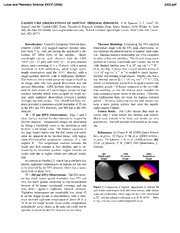
Cassini CIRS Observations of Iapetus' Thermal Emission PDF
Preview Cassini CIRS Observations of Iapetus' Thermal Emission
Lunar and Planetary Science XXXVI (2005) 2305.pdf CASSINI CIRS OBSERVATIONS OF IAPETUS’ THERMAL EMISSION. J. R. Spencer1 J. C. Pearl2, M. , Segura2 and the Cassini CIRS Team, 1Southwest Research Institute, Dept. Space Studies, 1050 Walnut St. Suite 400, Boulder CO 80304, [email protected], 2NASA-Goddard Spaceflight Center, Mail Code 693, Green- belt, MD 20771. Introduction: Cassini’s Composite Infrared Spec- Thermal Modeling: Combining the FP3 daytime trometer (CIRS, [1]) mapped Iapetus’ thermal emis- temperature maps with the FP1 dusk observation, we sion from 7 to ~300 µm during the spacecraft’s De- can constrain the thermal inertia of Iapetus’ dark mate- cember 31st 2004 flyby of the satellite. Short- rial. Thermal inertia is remarkably low even compared wavelength spectra were obtained with the CIRS to other airless icy satellites. The diurnal temperature “FP3” (10 - 17 µm) and “FP4” (7 - 10 µm) detector profiles of Europa, Ganymede and Callisto can be fit arrays, each consisting of 1 x 10 pixels with a spatial with thermal inertias near 5 x 104 erg cm-2 s-1/2 K-1, resolution of 0.29 milliradians, while longer wave- [3,4], but Fig. 3 shows that a lower thermal inertia of length observations used the “FP1” detector, with a ~3 x 104 erg cm-2 s-1/2 K-1 is needed to match Iapetus’ single-aperture detector with 4 milliradian diameter. daytime and evening temperatures. Phoebe also has a The detectors are scanned across the target to build up low thermal inertia (2.5 x 104 erg cm-2 s-1/2 K-1, [2]), an image cube with two spatial dimensions and one which we tentatively ascribed to its rapid rotation rate spectral dimension. CIRS daytime observations cov- (rotation period = 9 hours) compared to the icy Gali- ered the dark terrain of Cassini Regio, except for high lean satellites, so that the diurnal wave sampled the northern latitudes which were occupied by bright ter- least-compacted upper layers of the surface. However, rain, while nighttime observations covered a mixture this explanation does not work for Iapetus (rotation of bright and dark terrain. The 120,000 km flyby dis- period = 79 days), indicating that the dark terrain may tance provided a maximum spatial resolution of 35 km have a more porous surface than even the superfi- in the FP3 and FP4 detectors, and 500 km in the FP1 cially-similar Callisto. detector. Future Work: The CIRS Iapetus data were re- 10 – 17 µm (FP3) Observations: Figs. 1 and 2 ceived only 1 week before this abstract was written. show Iapetus’ daytime thermal emission as mapped by Much work remains to be done, and results are very the FP3 detector. Temperature images are determined preliminary. We will provide more details at the meet- by fitting a blackbody curve to the spectrum at each ing. location in the image cube. The thermal signature of the large impact basins near the disk center and termi- References: [1] Flasar, F. M. (2005) Space Science nator are apparent in the thermal image, with topog- Rev., in press.. [2] Flasar, F. M. et al. (2005) Science., raphically-controlled temperature contrasts of a few in press. [3] Spencer, J. R. et al. (1999) Science 284, degrees K. The temperature contrast between the 1514. [4] Spencer, J. R. (1987) PhD Dissertation, U. bright and dark terrains is less obvious, and is ob- Arizona. scured by the latitudinal gradient– higher latitudes are colder both due to higher albedo and reduced insola- tion. In contrast to Phoebe [2], which has a similarly low albedo, nighttime temperatures on Iapetus are too low to be detected by the FP3 detector, which has a sensi- tivity limit of about 70 K. 17 – 300 µm (FP1) Observations: The FP1 detec- tor has much lower spatial resolution than FP3 and FP4, but much greater sensitivity to low temperatures because of its longer wavelength coverage, and can Figure 1 Comparison of Iapetus’ appearance at thermal IR thus detect Iapetus’s nighttime thermal emission. and visible wavelengths (left, ISS press release, with similar Nighttime temperatures are remarkably low, about 45 scale and orientation). Phase angle for the CIRS observation K on the bright terrain at mid-latitudes, with a mini- is 52○, and the subspacecraft point is at 32 N, 69 W. Refer mum detected nighttime temperature of about 40 K at to Fig. 2 for the color-coded temperature scale. 75 N on the bright terrain. Even colder temperatures undoubtedly occur closer to the pole but could not be spatially resolved by the FP1 detector on this flyby. Lunar and Planetary Science XXXVI (2005) 2305.pdf Figure 2 Map of Iapetus temperatures derived from the observation in Fig. 1. The subsolar point is marked by a blue asterisk. Iapetus Diurnal Temperatures 140 120 100 K T, 80 60 40 0 90 180 270 360 Local Time Figure 3 Iapetus diurnal temperature profile, derived from FP3 10 – 17 µm data (dots) and a single FP1 sun- set measurement. The temperature profile derived from simple homogeneous thermal model is shown, with a best-fit thermal inertia of 3 x 104 erg cm-2 s-1/2 K-1 (red).
